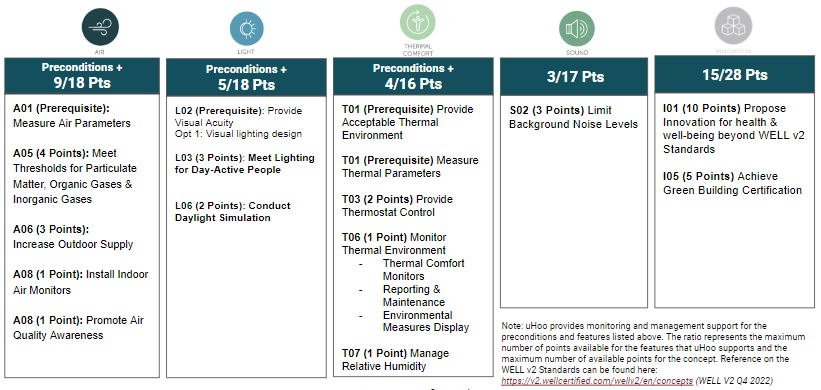
As our understanding of the connection between the environment and well-being continues to grow, it becomes increasingly evident that the built environments we live, work, and play present a crucial role in promoting health, productivity, and overall quality of life. In this article, we will unravel the WELL Building Standard, its principles, and how it has revolutionized the building industry.
What is the WELL building standard?
WELL is a performance-based system that evaluates, certifies, and monitors features of the built environment that impact human health and well-being. WELL is supported by a body of medical research that studies the relationship between buildings, where most of us spend 90% of our time, and our health as occupants.
Created by the International WELL Building Institute, the standard is currently recognised in a wide number of countries globally and can apply to new and existing buildings.
What is the International WELL Building Institute?
The International WELL Building Institute (IWBI) is a public benefit corporation and the world’s leading organization focused on transforming health and well-being in buildings, organizations and communities around the world. Its mission is to lead the global movement for putting people first in business decision-making and culture.
Concepts of the WELL building standard
The WELL Building Standard had its first version which was organized into seven categories: Air, Water, Nourishment, Light, Fitness, Comfort and Mind. In 2020, WELL expanded the categories (WELL v2) which is more comprehensive and focuses on concepts including:
Air
In this concept, buildings must mainly improve their indoor air quality. This can be achieved by maintaining a smoke-free environment in and around the property, having a properly functioning ventilation system, and making sure to minimize pollution during construction.
Water
This concept focuses on the provision of drinking water, water quality control, and the effective management and risk reduction of water quality.
Nourishment
While this might not sound like a building-related concern, nourishment is an important concept that will help provide a healthy environment for occupants. In this concept, healthy foods and the provision of transparent information on nutrition must be promoted.
Light
To collect points, exposure to daylight must be improved and indoor lightning must be comfortable for building occupants.
Movement
It is also important to promote movement within built environments to create and ensure a healthy environment. This can be achieved by offering fitness and physical activities to occupants and creating ergonomic workplaces within offices.
Thermal comfort
This concept is mainly focused on guaranteeing a temperature range that is comfortable for building occupants.
Sound
To gain points on this concept, noise levels should be maintained in its optimum range. Building operators can perform efforts such as introducing sound barriers and utilize modern audio devices.
Materials
The Materials concept focuses on promoting the use of safe and environmentally responsible materials in the built environment.
Mind
The “Mind” concept aims to create environments that support mental well-being, reduce stress, enhance cognitive performance, and foster a positive and productive mindset for the occupants.
Community
This concept aims to create environments that go beyond the building boundaries and positively impact the surrounding community. The focus is on promoting social connections, inclusivity, safety, and the overall well-being of both building occupants and the broader community.
Innovation (Bonus concept)
Innovation focuses on recognizing and rewarding projects that go beyond the standard requirements and demonstrate innovative strategies or technologies that promote health and well-being.
WELL certification levels
Projects pursuing WELL Certification can earn points based on performance outcomes for various policy, design and operational strategies and can achieve one of four certification levels: Bronze, Silver, Gold or Platinum.
- BRONZE CERTIFICATION – 40 points earned
- SILVER CERTIFICATION – 50 points earned
- GOLD CERTIFICATION – 60 points earned
- PLATINUM CERTIFICATION – 80 points earned
The benefits of becoming WELL-certified
The WELL Building Standard offers measurable advantages for business owners and facility managers. For example, a 10-year research from the Bentall Kennedy Study showed that owners of WELL-certified built environments are able to:
- increase rent by 3.7%
- Improve tenant retention by 6%
- Boost occupancy rate by 5-10%, and
- Experience 8-10% increased property value
Securing WELL points using uHoo Aura
uHoo Aura is the most comprehensive indoor environmental quality monitor that measures at least 13 factors affecting indoor environments.These factors include temperature, humidity, air pressure, carbon dioxide, carbon monoxide, PM1, PM2.5, PM4, PM10, formaldehyde, total volatile organic compounds, light, and sound. The device is also upgradable to measure two more parameters namely nitrogen dioxide and ozone or choose one among sulfur dioxide, oxygen, nitrogen dioxide, hydrogen sulfide, and ammonia, depending on your specific industry and/or requirements. Additionally, uHoo Aura comes with a dashboard that displays real-time status of the building’s IEQ.
WELL v2 concepts supported by uHoo Aura

Know exactly what’s in your indoor environment and be able to devise strategies to make your building healthy, safe, and WELL-certified using uHoo Aura.
